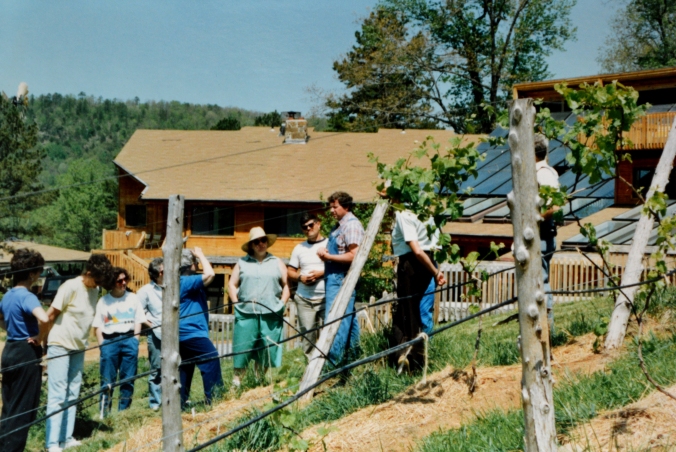Resilience Project now works in many countries and US States, but began in an impoverished Ozark valley at an virtually abandoned sustainable agriculture and renewable energy center: Meadowcreek. Meadowcreek flamed brightly and then faded, proving to be an unsustainable model. Resilience Project has a more flexible and diverse structure with projects and partners in many places. We must, however, understand our roots and history. Below is a history of Meadowcreek.
In 1979, the brothers David and Wilson Orr founded The Meadowcreek Project with the intention of creating a community built around the concepts of sustainable living, environmental protection, renewable energies and cooperation. During the 1980s the Meadowcreek Project became an important organization and the valley was seeing lots of exciting things happening. Through grants, gifts and fundraising, the organization financed various education programs, innovative projects and the construction of several cutting-edge buildings. In 1990 the property had an 18.000 sq ft. conference center, two dormitories, seven houses, a wood products shop, a maintenance shop and a renovated historic barn. It also included a staff of over 20 people who were leading the education programs, operating the farm and other projects and maintaining the facilities.
Unfortunately, funding for the Meadowcreek Project became very tight after 1990 and the founders left the valley. In 1993, the property and buildings were mortgaged to the Kerr Center for Sustainable Agriculture in Poteau, Oklahoma and became part of one of their demonstration programs. The distance and ongoing funding difficulties, however, made it unsustainable for the Kerr Center to keep Meadowcreek as a running operation and so the two separated in 1994, providing funding for one more year.
The Meadowcreek staff worked for almost two years developing projects and resources to keep the enterprise in business. The hope was that people would be drawn to the beauty of the valley and the various projects that were initiated, including renewable energy, organic food production and environmental education. The greatest successes were achieved through the educational programs for young people and adults that involved hands-on learning and experiences.
In the summer of 1995, the Humane Society of the United States (HSUS) held a family camp at Meadowcreek. The response was so positive that the HSUS leadership invited Meadowcreek to join its family of organizations as a demonstration of wildlife protection, sustainable agriculture and environmental protection. During the negotiating process, the Kerr Center and the HSUS agreed to dedicate 1200 acres of Meadowcreek property to preserve habitat for wildlife to be held by the newly formed division, the HSUS Wildlife Land Trust. This agreement erased the debt held by the Kerr Center and set Meadowcreek on a new incarnation under the leadership of the nation’s largest animal protection organization.
Meadowcreek thrived briefly under the mantel of the HSUS. Regional meetings and workshops were held on site and a number of other local, state and national organizations took advantage of the setting. Several of the former staff members remained in the valley and established their own businesses, including organic produce sold in a local farmers’ market, free range chickens raised in mobile pens, and wood products crafted in the wood shop. However, slowly more and more people left the valley and the maintenance of the buildings became too costly to keep up.
Meadowcreek, Inc. was formed in 2006 when the HSUS Wildlife Land Trust deeded approximately 400 acres of land and several buildings to a newly formed Board of Directors. Its goal is to restore the infrastructure of the property and to revive Meadowcreek, making it once again a viable education, recreation and demonstration center in the Ozark region.
Meadowcreek has lived through 40 years of different residents, businesses, and ups and downs. Its story will continue with new projects, people and dreams in the future. In the meantime, the wild creatures in and around us will continue to enjoy their home, as they always have.
For more pictures of the last 30 years see: a glimpse of the past






I worked at the Meadow Creek Project with the Orr children in the early 80’s. Glad to see it is still going strong. Would love to see if some of my work still stands. Keep up the good work!
LikeLike
Hey Richard, we’d love to hear about your experiences and what you built here. Truly, too much of the infrastucture that once was is dismantled or in some stage of decomposition now.
Though, we are making progress. We’re arranging purchasing a portable bandsaw to process wood on site, harvesting it from our own acreage to make flooring, chairs, etc. Much like what Meadowcreek was doing in the past.
One project we’re all looking forward to is reclaiming the conference center. Some time ago the roof started leaking and much mold has formed. We’re getting people excited about it and we’ll be hosting some group work days in the future to get some of the bulk work done. Anyways, Was great to get your feed back and would love to keep you updated on what we’re doing if you’re interested.
Cheers!
-Leesa
Project Coordinator
LikeLike
Hi Leesa, I long ago (1987?) attended a conference at Meadowcreek about nature/environmental writing and met David Brower there. After all these years, I am about to publish a book about John Muir and the creation of Yosemite National Park (Guardians of the Valley, Scribner 2023). Thought you guys might like to know. It all started there! Thanks and keep up the good work, Dean King
LikeLike